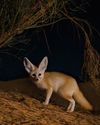The mouse map
BBC Wildlife
|August 2021
The harvest mouse is the smallest and least known of all British rodents, mainly because it is so difficult to find. A five-year citizen science survey in Kent is revealing valuable new information.

Ecologist Steve Kirk has a nose for harvest mice – or, more precisely, for the places they live. “You can be driving along with him,” says Suzanne Kynaston of the Wildwood Trust, “and he’ll suddenly shout ‘Stop the car!’ and jump out, and within minutes he’s found a nest in the verge.” It’s a remarkable skill: harvest mouse nests are notoriously difficult to find. Woven from living strips of leaf blade, they are beautifully camouflaged. But Steve insists there’s no trick to it, just a keen eye and insight honed by years of experience.
The popular image of the harvest mouse is of a tiny creature clinging to a stem of golden wheat, but the species’ natural habitat is long, grassy vegetation and reeds, such as might be found in rough pasture, scruffy margins, wetlands and ditches. As grass-stalk zone specialists, they spend their lives clambering from stem to stem – feeding, sleeping and breeding without ever needing to descend to the ground. In the days of less intensive agriculture, arable land was an extension of this natural habitat, and the mice were most often seen fleeing to the safety of field margins when crops were cut by hand – a scene described by 18th-century naturalist Gilbert White, who documented the natural history around his rural parish in Selborne.
Changes in agriculture mean crop fields are now seldom the haven they once were – and the mice that do venture into them are much less likely to survive the onslaught of a vast combine harvester. Meanwhile, many former wetland habitats have been converted to farmland or urban sprawl.
Bu hikaye BBC Wildlife dergisinin August 2021 baskısından alınmıştır.
Binlerce özenle seçilmiş premium hikayeye ve 9.000'den fazla dergi ve gazeteye erişmek için Magzter GOLD'a abone olun.
Zaten abone misiniz? Oturum aç
BBC Wildlife'den DAHA FAZLA HİKAYE

BBC Wildlife
"I was terrified the elephant would ram us"
African elephant in Kenya
2 mins
January 2026

BBC Wildlife
ALL YOU EVER NEEDED TO KNOW ABOUT THE Fennec fox
THE FENNEC FOX IS THE SMALLEST fox in the world, with a body length that can be as little as 24cm.
3 mins
January 2026

BBC Wildlife
INTO THE PLASTISPHERE
A unique synthetic ecosystem is evolving in our oceans – welcome to the plastisphere
7 mins
January 2026

BBC Wildlife
“More than half of all animal life exists in a parasitic relationship, and all life lives in symbiosis”
Our survival depends on species evolving to live together - but some relationships take dark turns
7 mins
January 2026

BBC Wildlife
Are animals able to dream?
SLEEP IS A MYSTERIOUS THING. FOR A long time, we weren't sure why we do it.
1 mins
January 2026

BBC Wildlife
Does a cuckoo know it's a cuckoo?
ABSURD LITTLE BIRDS ACROSS THE world lay their eggs in the nests of other species, leaving the hapless parents to raise a changeling at the expense of their own offspring.
2 mins
January 2026

BBC Wildlife
Orcas killing young sharks
Juvenile great whites are easy prey for orca pod
1 mins
January 2026

BBC Wildlife
Ocean goes on tour
Acclaimed film touring the UK, backed by live orchestra and choir
1 min
January 2026

BBC Wildlife
Feisty bats hunt like lions
Winged mammals use a 'hang and wait' strategy to take down large prey
1 mins
January 2026

BBC Wildlife
SNAP-CHAT
Richard Birchett on magical merlins, wily coyotes and charging deer
2 mins
January 2026
Translate
Change font size

